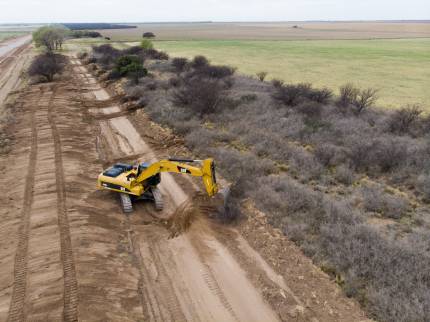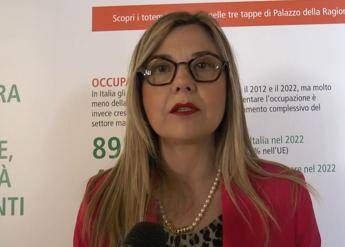
by María Victoria Emanuelli
Head of Campaigns at 350.org Latin America
BUENOS AIRES – Over the past few weeks, the term “gas pipeline” has dominated the discourse within Argentine public opinion. Specifically, it refers to the Néstor Kirchner pipeline. Why has this steel conduit, responsible for transporting gas, suddenly become the focal point of media discussions? The reasons are manifold: while the most prominent ones align with the prevailing economic and political narratives, there are other dimensions that are seldom addressed, such as the environmental, social, and climatic implications, as well as the long-term economic costs associated with Vaca Muerta. While the immediate economic gains may appear enticing, their sustainability in the medium term remains uncertain.
What lies behind the gas pipeline?
Located in Vaca Muerta, which serves as the origin of the gas pipeline, lies the world’s second-largest natural gas reserve and the fourth-largest unconventional oil reserve. Since its discovery, successive governments have hailed this deposit as the solution to two critical issues plaguing the country: the scarcity of natural gas, which has led to occasional imports from neighboring countries, and the dire need for foreign currency, exacerbated by the mounting public debt owed to the IMF. Vaca Muerta holds the potential to meet domestic energy demands, ensuring “energy independence” in the initial phase, and subsequently enable gas exports to generate much-needed revenue in the form of coveted dollars. For many, the gas pipeline is viewed as the pivotal element in this equation.
Furthermore, it is crucial to bear in mind that we are amidst an election year. The incumbent government has experienced a substantial decline in public approval and is grappling with the repercussions of an economic and political crisis. Complicating matters further, the Minister of Economy serves as the presidential candidate for the ruling party. In light of these circumstances, the construction of an epic narrative centered around the gas pipeline and Vaca Muerta has become indispensably strategic.
Not all that glitters is gold – or gas
This stance has remained consistent throughout Argentine history, transcending the political affiliation of the ruling government. Whether under Peronism or the Pro party, the country’s progress has been closely tied to the fossil fuel industry, making it one of the few sectors unaffected by the deep-rooted ideological divisions that permeate Argentine society.
As expected, in order to establish and propagate this almost epic narrative, there is a significant amount of information deliberately concealed from public view:
- Fracking* is an extremely expensive and resource-intensive technique, notably in terms of water usage. This is particularly concerning in a country that has recently endured a historic drought with severe consequences. Additionally, the extraction of sand, largely sourced from coastal and wetland areas, further exacerbates the environmental impacts.
- Due to this very reason, the Argentine government provides subsidies for fracking operations in Vaca Muerta. The government has implemented special currency transfer regulations to facilitate transactions for foreign companies involved in the industry.
- The socio-environmental consequences of fracking are highly significant, particularly for the local communities and natural ecosystems in the region. The practice leads to water and soil contamination, exacerbates water scarcity, causes frequent earthquakes, triggers health issues, and gives rise to new migratory populations that disrupt local economies, among numerous other problems.
- The expansion of fossil fuel-based energy contradicts the international pacts and agreements that Argentina is a signatory to. While the global North is rapidly transitioning towards renewable energy sources, Argentina is witnessing excessive investment in fossil fuels.
These costs are ultimately borne by the population, the environment, and the Argentine government, to which all the country’s inhabitants belong and contribute.
The gas pipeline in question, known as the Néstor Kirchner pipeline, spans a distance of 473 km from Tratayén (Neuquén) to Salliqueló (Buenos Aires). Its construction was completed in record time, and it began operations on June 20th of this year. The first segment of the pipeline alone stretches across four provinces, each with its unique environment and ecosystems. While environmental impact studies for the pipeline’s route were approved, concerns were raised in La Pampa, where it cuts through a native forest of Calden trees, disregarding the warnings of local residents. Past experiences with fossil fuel projects have shown that environmental controls tend to be weak and inadequate when powerful interests are at play.
Is it a solution or a problem?
The gas pipeline stands as a symbol of an unsustainable model built upon dependence on and expansion of fossil fuels.
A striking contradiction emerges. On the one hand, there is a push to utilize the financial resources of our indebted state to invest in and subsidize the extraction of unconventional gas and oil. Notably, 25% of the “Solidarity and extraordinary contribution to help mitigate the effects of the pandemic” has been allocated to hydrocarbon development. On the other, the lion’s share of profits predominantly benefits private capital, with YPF alone holding a 49% stake in such endeavors.
Argentina possesses all the necessary prerequisites for advancing renewable energy, supported by studies indicating that redirecting existing investments in fossil fuels towards these sustainable sources can expedite the energy transition and create a multitude of employment opportunities. This shift must be initiated without delay, as we persistently replicate a model marked by poverty, ecological devastation, violations of human rights, and regions sacrificed in the pursuit of fossil fuel ventures.
* Fracking, or hydraulic fracturing, is employed to extract gas and oil from Vaca Muerta by inducing fractures in the rock formations that contain these resources. This technique involves injecting substantial volumes of water infused with chemical additives at high pressure.
Victoria Emanuelli leads the 350.org campaigns in Latin American Spanish-speaking countries.
350.org is an international organization that believes in a safe climate and a better future — a prosperous and equitable world built with the power of ordinary people, driven by renewable energy and rooted in justice.
The post Behind Néstor Kirchner’s Gas Pipeline appeared first on 350.

 9 months ago
34
9 months ago
34

